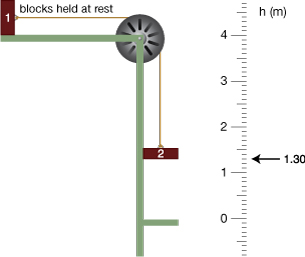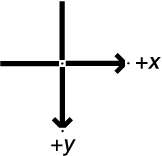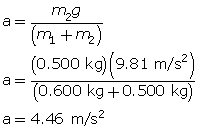Module 3—Effects of Force on Velocity
 Lesson 5 Lab: Fletcher’s Trolley
Lesson 5 Lab: Fletcher’s Trolley
Introduction
This lab simulates the motion of two masses connected by a string and pulley. You can explore the potential, kinetic, and total energy of the system. It also uses free-body analysis to determine the acceleration of the system, the tension in the string, and the weight acting on each block.
You can learn more about the simulation and how to use it by reading Show Me found at the top of the simulation screen.
Problem
How do you determine the acceleration of two connected bodies using Fletcher’s Trolley?
Open the Fletcher’s Trolley simulation; then continue with the procedure. You may be required to login with a username and a password. Contact your teacher for this information.
Procedure
Imagine two blocks connected by a rope. Now, imagine that one of the blocks is hung over the edge of a table via a pulley. What would happen to the blocks if they were free to move? Would both blocks begin to accelerate? If so, would they accelerate at the same rate if the rope does not stretch? The apparatus used to answer such questions is known as Fletcher's Trolley.

The simulation will be used to observe the acceleration of two blocks on Fletcher's Trolley.
- Click the “Reset” button (
 ).
).
- The lower edge of block 2 will be at elevation h = 1.30 m, and the yellow platform will be at h = 0 m.
- The masses of the blocks will be
m1 = 600 g
m2 = 400 g
- The pulley's mass will be zero. These mass values will be assumed in all of the following explanations, except where otherwise noted.
- Click on block 1, and drag it until block 2 is at elevation h = 3.00 m. Maximize the applet window (
 ) if you are not able to drag block 1 far enough to the left.
) if you are not able to drag block 1 far enough to the left.
- Click “Play” (
 ), and observe the motion of the blocks. You can click the “Data” button (
), and observe the motion of the blocks. You can click the “Data” button ( ) to see the values displayed and use “Rewind” and “Play” to see the action again. Describe the motion of the blocks using the terms speed, time, and acceleration.
) to see the values displayed and use “Rewind” and “Play” to see the action again. Describe the motion of the blocks using the terms speed, time, and acceleration.
Observations and Analysis
An engineer who wants to design a system with a specific acceleration must be able to calculate the acceleration from the parameters defining the system. In the case of Fletcher's Trolley, these parameters are the masses of the two blocks and the magnitude of the acceleration due to gravity (g). Given the parameters illustrated here, how can you calculate the magnitude of the acceleration (a) of the two blocks?
You know that gravity is providing acceleration on one of the blocks and that the two blocks have to accelerate at the same rate because they are attached by a string that can not stretch. Applying Newton's second law to the two blocks separately will give two equations for two unknowns. The two unknowns are acceleration and tension.

- Both blocks have accelerations of the same magnitude (a) because the string is assumed not to stretch.
- The pulley and the string are thought of as having no mass, and the pulley is considered to be frictionless. Therefore, the tension (T) in the string is equal along the entire length of the string. Suppose you denote the magnitude of the force on block 1 as T1 and the force on block 2 as T2. Then you can state that T, T1, and T2 are equal.
T = T1 = T2
The acceleration of the blocks can be determined by setting up two basic equations and solving them in terms of acceleration.
Setting Up the Basic Equations
Step 1: Define the directions. The coordinate axes (directions) are defined in the simulation.

- horizontal: positive to the right
- vertical: positive downward
Step 2: View the free-body diagrams (FBD) by clicking the “FBD” button (![]() ) that will illustrate the forces acting on each block. The FBD for block 2 is at the far right of the window.
) that will illustrate the forces acting on each block. The FBD for block 2 is at the far right of the window.
FBD 1 |
Equation for Block 1 |
FBD 2 |
Equation for Block 2 |
N1 and W1 cancel |
Applying Newton's second law (Fnet = ma) to block 1 yields the following equation:
Fnet = T1
m1a = T1 (1) |
 |
Applying Newton's second law (Fnet = ma) to block 2 yields the following equation:
Fnet = (+W2) + (–T2)
m2a = m2g – T2 (2) |
 Module 3: Lesson 5 Assignment
Module 3: Lesson 5 Assignment
Remember to submit the answer to LAB 1 to your teacher as part of your Module 3: Lesson 5 Assignment.
LAB 1. Equations (1) and (2) are the fundamental equations governing the motion of the system. Each of these equations can be used independently to determine the tension in the string.
- Using equation (1), calculate the tension in the string if m1 = 0.600 kg and a = 3.92 m/s2. Show your work. Verify your answer using the applet.
- Using equation (2), calculate the tension in the string if m2 = 0.400 kg and a = 3.92 m/s2. Show your work. Verify your answer using the applet. Your answer should be identical to LAB 1.a.
Step 3: Combine equations (1) and (2) to generate an equation to solve for the acceleration of the system.
(2) m2a = m2g – T2
T2 = m2g – m2a
(1) T1 = m1a
m1a= m2g – m2a
m1a + m2a = m2g
Express equation (2) in terms of T2. Use the fact that T2 = T1 to equate equations (1) and (2).

Manipulating the equation in terms of acceleration gives

Solving for the acceleration gives
Verify that this is the value for the acceleration as displayed by the applet.
 Self-Check
Self-Check
SC 1. Given the following masses, calculate the acceleration of the system.
m1 = 0.600 kg
m2 = 0.500 kg
Show your work. Verify your answer on the applet by adjusting the mass values to match those given. The mass values on the applet are controlled by the mass slider. You can make fine mass adjustments by clicking in the slot to the left or right of the slider.
 Self-Check Answers
Self-Check Answers
SC 1.

The simulation uses the rounded value 9.8 m/s2 for g and therefore calculates the acceleration to be 4.45 m/s2.
 Module 3: Lesson 5 Assignment
Module 3: Lesson 5 Assignment
Remember to submit the answer to LAB 2 to your teacher as part of your Module 3: Lesson 5 Assignment.
LAB 2. Given the following masses, calculate the acceleration of the system.
m1 = 0.600 kg
m2 = 0.800 kg
Verify your answer on the applet by adjusting the mass values to match those given. The mass values on the applet are controlled by the mass slider. Show your work.
How can you calculate the tension present in the string when the blocks are moving?
The tension is not measured as easily as the acceleration. You would have to insert a strain gauge into the string, which would have a mass. This would have an effect on the conditions in the system, including the tension. Therefore, it is particularly important that you know how to calculate the tension. For example, an engineer who needs to design a system like Fletcher's Trolley will want to know how strong to make the string so that it will not break under the tension that it will need to sustain.
If the acceleration has already been measured or calculated, the easiest way to find the tension is to substitute the value for acceleration (a) into either equation (1) or (2).
Using Equation 1

Using Equation 2

The simulation displays a value of 2.4 N, which is consistent with these calculations.
 Module 3: Lesson 5 Assignment
Module 3: Lesson 5 Assignment
Remember to submit the answer to LAB 3 to your teacher as part of your Module 3: Lesson 5 Assignment.
LAB 3. Notice that the tension value of 2.35 N is less than the weight of block 2. The weight of block 2 is calculated by W2 = m2g = (0.400 kg) (9.81 m/s2) = 3.92 N
What would the acceleration of the system be if the tension were equal to the weight of block 2? Explain your answer. (Hint: Study the free-body diagram of block 2 to answer this.)
Conclusion
The acceleration of two connected bodies on Fletcher’s Trolley can be determined by setting up two basic equations and solving them in terms of acceleration.
